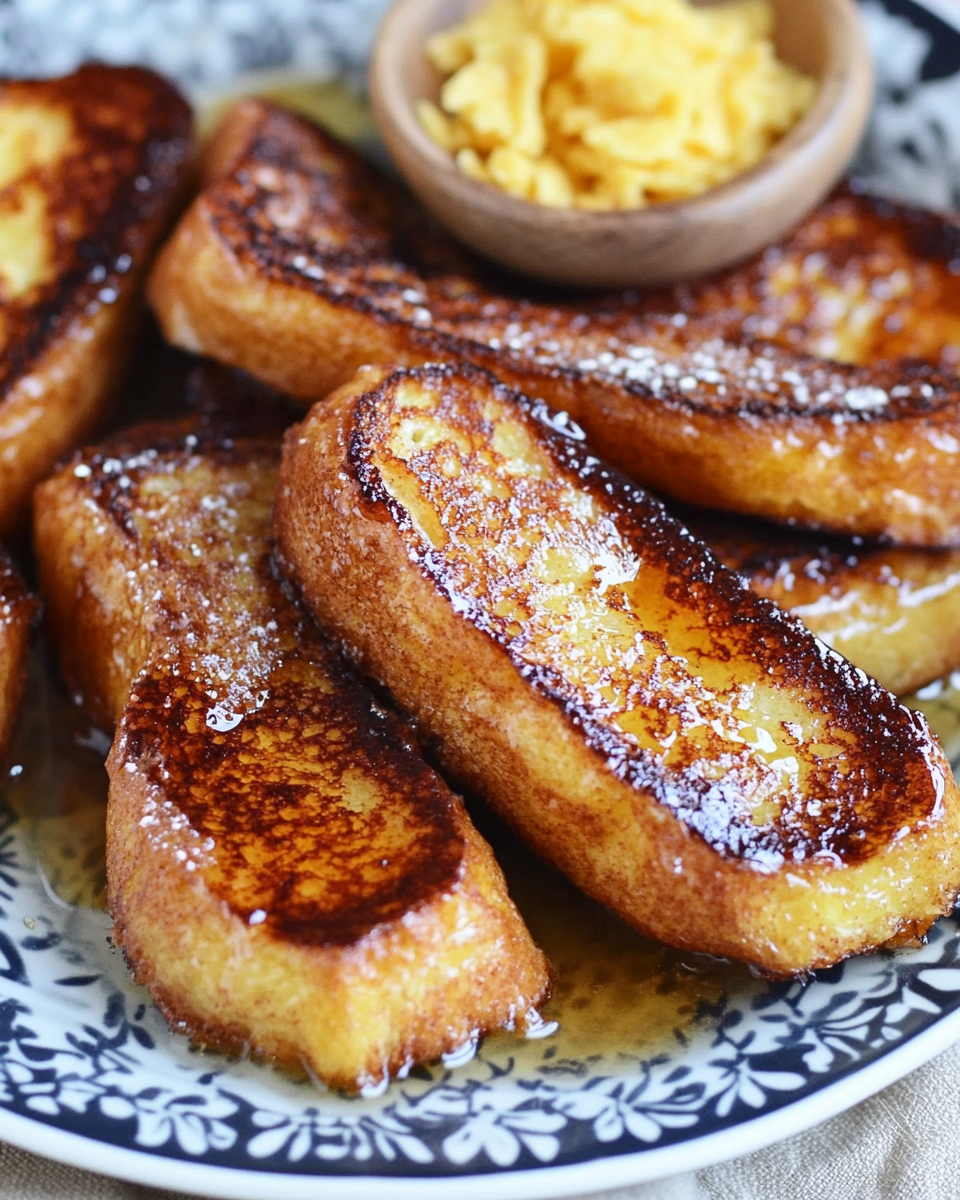Torrijas, a traditional Spanish dessert, is similar to French toast but with a twist. It’s typically enjoyed during special holidays and celebrations, often soaked in a delicious syrup made with honey, cinnamon, and anise. Perfect for a sweet treat, torrijas can be served either warm or at room temperature and are a great way to enjoy stale bread in a whole new way.
Full Recipe:
Ingredients
For the syrup:
-
1 ½ cups water
-
1 cup granulated sugar
-
½ cup honey
-
1 tablespoon fresh orange zest
-
½ teaspoon kosher salt
-
2 cinnamon sticks
-
¼ teaspoon anise extract
-
½ teaspoon almond extract
For the batter:
-
2 large eggs
-
1 ½ cups whole milk
-
4 tablespoons butter
-
Flaky sea salt, for garnish
For the bread:
-
1 thick, stale French or Italian-style baguette
Directions
-
Slice the baguette into 1-inch thick slices on the bias.
-
Make the syrup: Combine the water, sugar, honey, orange zest, salt, and cinnamon sticks in a medium saucepan. Bring it to a boil for 1 minute, then reduce the heat and simmer for 7-10 minutes, allowing it to reduce into a thin syrup. Remove from heat and stir in the anise and almond extracts.
-
Prepare the batter: In a shallow bowl, whisk together the eggs and milk. Dip each slice of bread into the batter for 30 seconds to 1 minute (but don’t let it get too soggy).
-
Melt 2 tablespoons of butter in a large skillet. Fry the soaked bread slices in batches for about 3 minutes per side, or until golden brown. Add more butter as needed.
-
Once fried, place the torrijas on a slightly concave or rimmed platter and cover with the syrup. Allow it to soak for at least 20 minutes before serving.
-
Serve warm or at room temperature, finishing off with a bit of flaky sea salt if desired.
Nutritional Value (Per Serving):
-
Calories: 350-450 kcal (depending on the size of the bread slices and the amount of syrup absorbed)
-
Fat: 15-20g
-
Saturated Fat: 8-10g (mainly from butter)
-
-
Carbohydrates: 50-55g
-
Sugars: 25-30g (from honey, sugar, and syrup)
-
Fiber: 1-2g (from the bread)
-
-
Protein: 6-8g (from the eggs and milk)
-
Cholesterol: 90-110mg (due to the eggs and butter)
-
Sodium: 150-200mg (mostly from the kosher salt and butter)
-
Calcium: 80-100mg (from milk)
-
Iron: 1-2mg
This is just an estimate, and the actual values will depend on specific brands and amounts used for ingredients.
The Syrup: A Key Ingredient in Torrijas
The syrup in torrijas is what sets this dish apart from typical French toast. Made with a combination of water, granulated sugar, honey, orange zest, cinnamon sticks, and a touch of anise and almond extracts, the syrup is aromatic and full of deep, complex flavors. The honey adds a natural sweetness, while the cinnamon sticks and orange zest contribute a warm, citrusy aroma that is quintessential to the Spanish version of this dish.
Anise extract, while optional, imparts a delicate, slightly licorice-like flavor that complements the sweetness of the syrup. Almond extract brings a subtle nuttiness, rounding out the syrup’s flavor and enhancing the bread as it soaks up the sweet liquid. The syrup is simmered until it reduces slightly, thickening into a luscious, golden sauce that is drizzled generously over the fried bread slices.
Battering the Bread: Soaking Without Sogging
One of the secrets to achieving the perfect torrija is soaking the bread just long enough for it to absorb the syrup and batter but not become overly soggy. The bread slices, typically made from a thick, stale French or Italian-style baguette, are dipped into a mixture of eggs and milk. This batter helps create a golden, crispy crust on the outside of the bread when fried, while the inside remains soft and custardy.
It’s important not to let the bread sit in the batter for too long—just enough to ensure it’s well-soaked without turning mushy. Ideally, 30 seconds to 1 minute is enough time for each slice, depending on the thickness of the bread. Once the slices are fully coated, they’re ready for frying.
Frying to Perfection: Golden and Crisp
To fry the torrijas, you’ll need a large skillet and a generous amount of butter. The butter adds a rich, creamy flavor to the fried bread, helping it to crisp up beautifully while also contributing to the decadent texture of the finished dish.
Fry the bread slices in batches for about 3 minutes per side, or until they reach a golden brown color. Adding butter as needed helps ensure each slice cooks evenly and doesn’t stick to the pan. The end result is crispy on the outside with a soft, custardy interior—delicious on its own but made even better once drizzled with the aromatic syrup.
Soaking and Serving
After frying, place the torrijas on a slightly concave or rimmed platter to help catch any syrup that may drip. Pour the warm syrup over the fried slices, allowing them to soak in the sweet liquid. For the best results, let the torrijas sit for at least 20 minutes before serving, giving the bread time to absorb the syrup and achieve that perfect balance of sweetness and flavor.
These can be served either warm or at room temperature, making them a versatile treat. If desired, you can sprinkle a touch of flaky sea salt over the top before serving, which adds a delightful contrast to the sweetness and enhances the overall flavor.
Nutritional Benefits
Torrijas, while indulgent, also offer some nutritional benefits. They contain a mix of carbohydrates, proteins, and fats, making them a filling snack or dessert. The bread provides carbohydrates, while the eggs and milk in the batter contribute protein. The butter used in frying adds healthy fats, although it also increases the dish’s saturated fat content.
While torrijas are typically high in sugar—thanks to the syrup—the honey used in the recipe offers a more natural sweetness compared to refined sugars. Additionally, the use of whole milk adds calcium to the dish, while the orange zest contributes a small amount of vitamin C.
Despite their nutritional benefits, torrijas are a treat best enjoyed in moderation, as they are quite rich and calorie-dense, primarily due to the butter and sugar content. However, for a special occasion or when you’re craving a comforting dessert, torrijas provide an incredibly satisfying and delicious option.
Serving Suggestions
Torrijas are versatile and can be enjoyed in a variety of ways. They’re commonly served for breakfast or dessert, particularly during holidays like Easter in Spain. You can enjoy them as they are, or pair them with a scoop of vanilla ice cream for an extra indulgent treat. Fresh fruit like berries or citrus slices also pairs wonderfully with torrijas, providing a refreshing contrast to the sweetness of the syrup.
For a lighter version, you can reduce the amount of syrup or use a sugar substitute. However, the traditional syrup made with honey and cinnamon is what makes torrijas so special and nostalgic for many.
Conclusion: A Sweet Spanish Tradition
Torrijas are the perfect blend of sweetness, warmth, and texture, and they offer a new way to enjoy stale bread. With their rich, syrupy soak and golden, crispy exterior, they make for a comforting and indulgent treat. Whether you’re looking for a festive dessert, a breakfast treat, or simply something to sweeten up your day, torrijas are sure to please.
This Spanish dessert brings together the flavors of honey, cinnamon, and citrus, making it a crowd-pleaser for both those familiar with the tradition and newcomers alike. Perfect for sharing with loved ones during special occasions, torrijas are a timeless recipe that captures the essence of Spanish culinary heritage in every bite.

